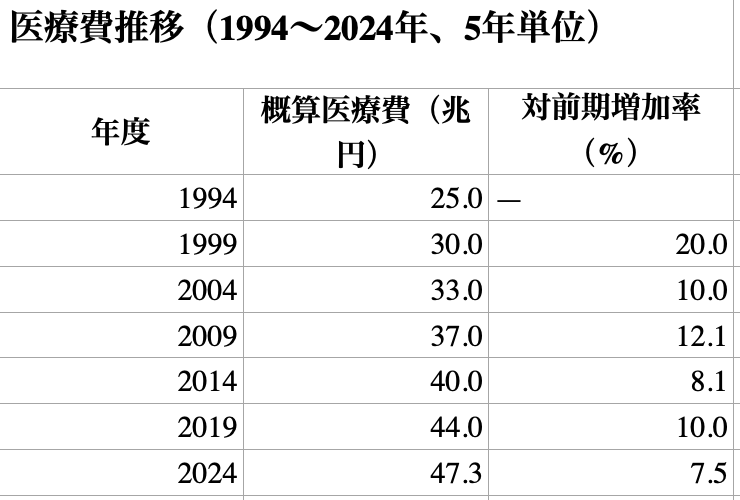医療費は年々増加し続けており、特に成人病(生活習慣病)の治療費が大きな割合を占めています。
予防できるところは自分も含めて予防することは結果的に血管系が健康になるので回復も最大化させることができますよね
(「予防」と聞くと特に病気ではない人は該当しないように感じてしまって人気がありません。苦笑
毎日、怪我や病気がなく健康であることは失った時に普段の日常が本当に感謝に値しますが、なぜなんだ。)
身体の体内の状態のレベルは千差万別です
健康だと思っていても、実はそうでもなかったと乖離があったりしますね
厚生労働省のデータによると、日本の総医療費は以下のように推移しています:
– 2010年度:37.4兆円
– 2015年度:42.4兆円
– 2020年度:約45.8兆円
特に高齢化の進展に伴い、心疾患、糖尿病、脳血管疾患、がんなどの生活習慣病が、治療費全体の大部分を占めています。これらは食生活、運動不足、喫煙、ストレスなどの生活習慣が大きく影響していますが喫煙外来が保険適用になるのが意味分かりませんね。
(アメリカでは、医療ミスが死因の第3位とされています。
ジョンズ・ホプキンス大学の2016年の研究によると、医療ミスによる死亡者数は年間約25万人に達し、心疾患(第1位)、がん(第2位)に次ぐ死因のようです)
1. 治療費の内訳と患者負担
– 糖尿病患者の場合:年間の治療費は1人当たり約30万円に達します。インスリン治療や合併症治療が含まれるとさらに増加します。
-心筋梗塞の治療費:緊急治療や入院費で平均的に200万円以上がかかります。
-アルツハイマー病の治療費は、患者一人あたり年間約300万円 らしいのですが病気になると非常にお金も労力もとてもかかります。
ちなみに睡眠不足によって生産性が減ったりするのでその経済的損失は年間約15兆円のようです。
(ちゃんと睡眠取れるようなったら15兆円GDPの3%上がるという計算。睡眠とったら3%売上上がると考えたら超大きい)
2. 予防による経済効果
– 健康管理や予防を徹底することで、これらの疾病を未然に防ぐことができます。例えば、生活習慣を改善した糖尿病予備群の人々では、年間の医療費が約20%削減されたという研究があります。
増え続ける医療費の負担を減らすには、病気の治療に頼るのではなく、予防に重点を置くことですが
予防という言葉に変わる良い表現ないですかね。
予防と治療は基本的に全く同じであるべき。
あとがき(独り言):
腰痛になったら、腰痛予防でやることをしたらそれが治療になります。
スポーツで怪我をした時のリハビリは、予防のトレーニングと強度の違いはあれど考えは全く同じです。
悪くなった過程を巻き戻し再生したら、良くなり根本的な治療になるはずで同じラインの上ですが、
予防と治療は別ラインのものになっているし、予防とトレーニングも同じラインのことですが、別のラインものとして認識してる人もいたりします
Rising Healthcare Costs and the Importance of Prevention
Healthcare costs have been steadily increasing, with treatment for adult diseases (lifestyle-related diseases) accounting for a significant portion of the total. By focusing on prevention—not just for others but for ourselves as well—we can maintain healthier vascular systems, which in turn maximizes the body’s ability to recover.
Prevention Isn’t Popular
The term “prevention” often seems irrelevant to people who don’t consider themselves sick, making it less popular as a concept. Ironically, staying injury-free and healthy every day is something we only truly appreciate once it’s lost. Why is that?
The Complexity of Internal Health
The internal state of each person’s body varies greatly. Even if someone believes they are healthy, there is often a gap between perception and reality.
According to data from the Japanese Ministry of Health, Labour and Welfare, Japan’s total healthcare costs have progressed as follows:
– 2010: ¥37.4 trillion
– 2015: ¥42.4 trillion
– 2020: Approximately ¥45.8 trillion
The aging population has significantly contributed to this rise, with lifestyle diseases such as heart disease, diabetes, cerebrovascular disease, and cancer making up a large portion of treatment costs. These conditions are heavily influenced by lifestyle factors such as diet, lack of exercise, smoking, and stress. Yet, curiously, smoking cessation programs are covered by insurance.
In the U.S., medical errors rank as the **third leading cause of death**, according to a 2016 study by Johns Hopkins University. Approximately 250,000 deaths annually are attributed to medical errors, ranking just behind heart disease (1st) and cancer (2nd).
1. Breakdown of Treatment Costs and Patient Burden
– Diabetes: Annual treatment costs per patient can reach around ¥300,000, increasing further if insulin therapy or treatments for complications are needed.
– Heart Attacks: Emergency treatment and hospitalization average over ¥2 million.
– Alzheimer’s Disease: Treatment costs per patient are estimated at ¥3 million annually, demonstrating how illnesses can be both financially and physically draining.
Sleep deprivation, on the other hand, reduces productivity and results in an annual economic loss of around ¥15 trillion in Japan. Addressing sleep deprivation alone could boost GDP by approximately 3%. That’s an enormous gain—imagine if a business could increase sales by 3% just by ensuring everyone got enough sleep.
2. Economic Benefits of Prevention
Proactive health management and prevention can help avoid these illnesses altogether. For example, studies have shown that individuals with prediabetes who improve their lifestyle can reduce annual healthcare costs by approximately 20%.
To curb the growing burden of healthcare costs, focusing on prevention rather than relying on treatment is essential.
Is There a Better Word Than “Prevention”?
The word “prevention” sometimes creates the perception of being irrelevant or separate from everyday health. However, prevention and treatment should essentially be viewed as the same thing.
Personal Reflection: Prevention = Rehab
If you develop back pain, the actions you take to prevent worsening it often become the treatment itself. Similarly, rehabilitation after a sports injury is conceptually the same as preventative training, albeit with adjusted intensity.
Rewinding and reversing the process that led to poor health results in genuine healing and addresses the root cause. While prevention and treatment are often perceived as different, they are merely points along the same continuum. Recognizing this unity could revolutionize how we approach health and wellness.

